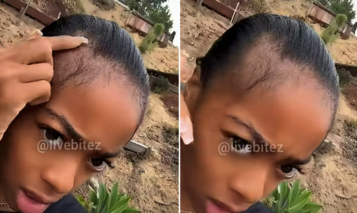
Jada Pinkett-Smith‘s fans assumed she wore colorful turbans to protect her natural tresses from the stress of excess heat and hairstyling. The truth is the 46-year-old mother-of-2 is losing her hair.
“A lot of people have been asking why I’ve been wearing turbans,” Pinkett Smith, said on the latest episode of her Facebook Watch web series Red Table Talk. “Well, I haven’t talked about it. It’s not easy to talk about, but I am going to talk about it.”
Pinkett Smith told People.com she first realized she was losing her hair while taking a shower.
“It was terrifying when it first started. I was in the shower one day and then just handfuls of hair just in my hands. And I was just like, ‘Oh my God, am I going bald?’.”
“It was one of those times in my life where I was literally shaking in fear. That’s why I cut my hair, and why I continue to cut it,” she added.
Unlike other Hollywood starlets, Pinkett Smith rarely wore hair weave or extensions. The ‘Girls Trip’ star took pride in her long, lustrous tresses.
“My hair has been a big part of me,” Pinkett Smith said. “Taking care of my hair has been a beautiful ritual and having the choice to have hair or not. And then one day to be like, ‘Oh my god, I might not have that choice anymore.’ ”
Earlier this year she decided it was time for the big chop — and rather than wear her hair in a buzzcut, she now wears turbans.
The following are 5 reasons why women lose their hair.
1. Perimenopause and Menopause
With middle-age comes perimenopause and menopause. One of the first signs after menopause is excessive hair shedding caused by the loss of Estrogen and Progesterone hormones.
As Estrogen and Progesterone levels decline, Testosterone becomes the dominant hormone in women. Testosterone and its metabolite Dihydrotestosterone (DHT) is death to a woman’s hair follicles. DHT also causes hirsutism (excessive facial/body hair growth) and male-pattern hair loss around the edges, ears and crown.
Testosterone converts to DHT with the aid of the enzyme 5-alpha reductase. DHT attacks hair follicles when sebum (skin oils) builds up on the scalp and the DHT becomes trapped in the oil. DHT binds to the hair follicle causing the follicles to shrink. hair is very thin at the roots and breaks off easily. The hair strand is very fine at the point of breakage.
2. Thyroid Disease
Hypothyroidism (underactive thyroid) means your thyroid isn’t making enough thyroid hormones (T4 and T3) or your T4 isn’t converting into the active form (T3) that is required at the cellular level.
Signs and symptoms of hypothyroidism (underactive thyroid) include:
Most women who experience these signs and symptoms often don’t realize they have under-active thyroid because their thyroid lab test results are “in normal range.” Hashimoto’s thyroiditis is the most common form of hypothyroidism. It is an autoimmune disorder that causes the immune system to attack the thyroid. Hashimoto’s results in hair loss and bald patches (Alopecia Areata).
Hair shedding is also a sign of hyperthyroidism (overactive thyroid). Hypothyroidmom.com is an excellent resource for sufferers of underactive thyroid who want an easy-to-understand explanation of hyperthyroidism.
Consult your doctor if you believe you may have a thyroid disorder. Your doctor will draw blood for a compete Thyroid Panel, which includes:
4. Vitamin Deficiency (Low Iron, Low Vitamin D)
Iron deficiency and Vitamin D deficiency are the main culprits of hair loss caused by vitamin deficiency. Iron deficiency is the most common cause of anemia. An over-the-counter iron supplement should correct the problem. Consult your doctor for blood work to test your CBC and Ferritin (iron stores) levels.
Vitamin D deficiency is one of the top causes of brain fog and hair breakage or shedding. Most people get all the Vitamin D they need by exposing their bare skin to the sun for as little as 15 minutes a day. Dark skin Black people are more prone to Vitamin D deficiency because the melanin in our skin blocks the UV rays from the sun.
For Black people who don’t get enough sun, supplementing with Vitamin D is very necessary. It is important to take Vitamin D and Magnesium together. Magnesium is required to convert Vitamin D into its active usable form so it can be absorbed in your bloodstream.
5. Polycystic Ovarian Syndrome (PCOS)
Polycystic Ovarian Syndrome (PCOS) causes hair loss and hair shedding due to increased male hormone testosterone and male androgen DHT. Polycystic Ovary Syndrome (PCOS) is a condition that leads to cysts on the ovaries. PCOS makes your cells less responsive to insulin (insulin resistance).
If your cells become resistant to insulin your insulin level will increases in your bloodstream. Increased insulin leads to increased production of androgens (DHT), which causes cystic acne, hirsutism (excess facial hair and male-pattern hair loss in women).
Studies have shown women with PCOS have low-grade inflammation in the body that stimulates polycystic ovaries to increase male androgen in the blood. Risk factors for PCOS include obesity and diabetes Type 2.
6. STRESS
High stress can cause inflammation that results in thinning hair and shedding. Stress can trigger a type of hair loss called telogen effluvium (shedding phase). “When you have a really stressful event, it can shock the hair cycle, (pushing) more hair into the shedding phase,” explains Marc Glashofer, MD, a dermatologist in New York City. Hair loss is more pronounced about 3 months after a stressful event, such as a death in the family or job loss.
Bonus tips for hair shedding and acne:
1. Drink Spearmint Tea to decrease testosterone and DHT.
Studies have shown that spearmint tea decreases the levels of testosterone and DHT in women with PCOS. Spearmint tea works wonders for both men and women who suffer from cystic acne, male-pattern hair loss and hair shedding.
You can buy Spearmint tea in stores, online, or your can make it yourself at home.
Here is a my favorite Spearmint tea.
2. Read Hypothyroidmom to gain a better understanding of hypothyroidism and treatments to stop hair loss.
DISCLAIMER
Any medical information published on this blog is for your general information only and is not intended as a substitute for informed medical advice. You should not take any action before consulting with your personal physician or a health care provider. Sandrarose.com and its affiliates cannot be held liable for any damages incurred by following information found on this blog.





